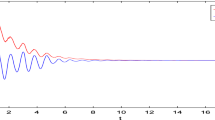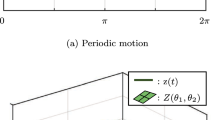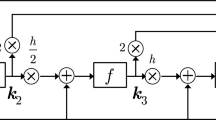Abstract
This article is devoted to the global dissipativity of inertial neural networks with proportional delay. A novel generalized Halanay inequality which involves proportional delay is established. By constructing a new generalized Halanay inequality, several new explicit delay-independent conditions are derived in terms of linear matrix inequalities to ensure the global dissipativity of the considered system. Moreover, a new differential delay inequality which involves unbounded time-varying delay is considered. Due to the proportional delay is one type of unbounded time-varying delays, new analysis techniques can effectively avoid the difficulties caused by proportional delay by applying a new differential delay inequality. Especially, several novel delay-dependent sufficient conditions are obtained to guarantee the global dissipativity of the considered system. Finally, two simulations examples are provided to illustrate the validity of the proposed theoretical analysis.




Similar content being viewed by others

References
Li C, Yu X, Huang T, He X (2017) Distributed optimal consensus over resource allocation network and its application to dynamical economic dispatch. IEEE Trans Neural Netw Learn Syst. https://doi.org/10.1109/TNNLS.2017.2691760
He X, Ho D, Huang T, Yu J, Abu-Rub H, Li C (2017) Second-order continuous-time algorithms for economic power dispatch in smart grids. IEEE Trans Syst Man Cybern Syst. https://doi.org/10.1109/TSMC.2017.2672205
Li H, Jiang H, Hu C (2016) Existence and global exponential stability of periodic solution of memristor-based BAM neural networks with time-varying delays. Neural Netw 75:97–109
Wen S, Zeng Z, Huang T, Meng Q (2015) Lag synchronization of switched neural networks via neural activation function and applications in image encryption. IEEE Trans Neural Netw Learn Syst 26:1493–1502
Huang T, Li C, Duan S, Starzyk J (2012) Robust exponential stability of uncertain delayed neural networks with stochastic perturbation and impulse effects. IEEE Trans Neural Netw Learn Syst 23(6):866–875
Babcock K, Westervelt R (1986) Stability and dynamics of simple electronic neural networks with added inertia. Phys D 23(1–3):464–469
Yang X, Ho D (2016) Synchronization of delayed memristive neural networks: robust analysis approach. IEEE Trans Cybern 46(12):3377–3387
He X, Li C, Huang T, Li C, Huang J (2014) A recurrent neural network for solving bilevel linear programming problem. IEEE Trans Neural Netw Learn Syst 25:824–830
Yang X, Cao J, Liang J (2017) Exponential synchronization of memristive neural networks with delays: interval matrix method. IEEE Trans Neural Netw Learn Syst 28(8):1878–1888
Zeng Z, Huang T, Zheng W (2010) Multistability of recurrent neural networks with time-varying delays and the piecewise linear activation function. IEEE Trans Neural Netw Learn Syst 21:1371–1377
Huang H, Huang T, Chen X (2013) A mode-dependent approach to state estimation of recurrent neural networks with Markovian jumping parameters and mixed delays. Neural Netw 46:50–61
Li C, Li C, Liao X, Huang T (2011) Impulsive effects on stability of high-order BAM neural networks with time delays. Neurocomputing 74:1541–1550
Li X, Song S (2013) Impulsive control for existence, uniqueness andglobal stability of periodic solutions of recurrent neural networks with discrete and continuously distributed delays. IEEE Trans Neural Netw Learn Syst 24:868–877
Qi J, Li C, Huang T (2015) Stability of inertial BAM neural network with time-varying delay via impulsive control. Neurocomputing 161:162–167
Li H, Li C, Huang T (2017) Periodicity and stability for variable-time impulsive neural networks. Neural Netw 94:24–33
Feng Y, Li C, Huang T (2016) Periodically multiple state-jumps impulsive control systems with impulse time windows. Neurocomputing 193:7–13
Wheeler D, Schieve W (1997) Stability and chaos in an inertial two-neuron system. Phys D 105(4):267–284
He X, Huang T, Yu J, Li C, Li C (2017) An inertial projection neural network for solving variational inequalities. IEEE Trans Cybern 47(3):809–814
Wan P, Jian J (2017) Global convergence analysis of impulsive inertial neural networks with time-varying delays. Neurocomputing 245:68–76
Zhang W, Huang T, He X, Li C (2017) Global exponential stability of inertial memristor-based neural networks with time-varying delayed and impulses. Neural Netw. https://doi.org/10.1016/j.neunet.2017.03.012
Tu Z, Cao J, Hayat T (2016) Matrix measure based dissipativity analysis for inertial delayed uncertain neural networks. Neural Netw 75:47–55
Tu Z, Cao J, Alsaedi A, Alsaadi F (2017) Global dissipativity of memristor-based neutral type inertial neural networks. Neural Netw 88:125–133
Hu J, Cao J, Alofi A, Abdullah AM, Elaiw A (2015) Pinning synchronization of coupled inertial delayed neural networks. Cogn Neurodyn 9(3):341–350
Song Q, Cao J (2008) Global dissipativity analysis on uncertain neural networks with mixed time-varying delays. Chaos Interdiscip J Nonlinear Sci 18(4):043126
Song Q (2011) Stochastic dissipativity analysis on discrete-time neural networks with time-varying delays. Neurocomputing 74(5):838–845
Feng Y, Peng Y, Zou L, Tu Z, Liu J (2017) A note on impulsive control of nonlinear systems with impulse time window. J Nonlinear Sci Appl 10:3087–3098
Tu Z, Jian J, Wang B (2011) Positive invariant sets and global exponential attractive sets of a class of neural networks with unbounded time-delays. Commun Nonlinear Sci Numer Simul 16(9):3738–3745
Lu B, Jiang H, Abdurahman A, Hu C (2016) Global generalized exponential stability for a class of nonautonomous cellular neural networks via generalized Halanay inequalities. Neurocomputing 214:1046–1052
Chen T, Liu X (2017) \(\mu \)-stability of nonlinear positive systems with unbounded time-varying delays. IEEE Trans Neural Netw Learn Syst. https://doi.org/10.1109/TNNLS.2016.2533392
Song Q, Zhao Z (2005) Global dissipativity of neural networks with both variable and unbounded delays. Chaos Solitons Fractals 25(2):393–401
Li X, Cao J (2017) An impulsive delay inequality involving unbounded time-varying delay and applications. IEEE Trans Autom Control. https://doi.org/10.1109/TAC.2017.2669580
Zhou L (2015) Novel global exponential stability criteria for hybrid BAM neural networks with proportional delays. Neurocomputing 161:99–106
Zhou L, Zhang Y (2016) Global exponential stability of a class of impulsive recurrent neural networks with proportional delays via fixed point theory. J Franklin Inst 353(2):561–575
Zheng C, Li N, Cao J (2015) Matrix measure based stability criteria for high-order neural networks with proportional delay. Neurocomputing 149:1149–1154
Song X, Zhao P, Xing Z, Peng J (2016) Global asymptotic stability of CNNs with impulses and multi-proportional delays. Math Methods Appl Sci 39(4):722–733
Zhou L (2014) Global asymptotic stability of cellular neural networks with proportional delays. Nonlinear Dyn 77(1–2):41–47
Liao X, Wang J (2003) Global dissipativity of continuous-time recurrent neural networks with time delay. Phys Rev E Stat Nonlinear Soft Matter Phys 68(2):016–118
Wen L, Yu Y, Wang W (2008) Generalized Halanay inequalities for dissipativity of Volterra functional differential equations. J Math Anal Appl 347(1):169–178
Lu H (2002) Chaotic attractors in delayed neural networks. Phys Lett A 298(2–3):109–116
Long S, Wang X, Li D (2012) Attracting and invariant sets of non-autonomous reaction-diffusion neural networks with time-varying delays. Math Comput Simul 82(11):2199–2214
Feng Z, Lam J (2011) Stability and dissipativity analysis of distributed delay cellular neural networks. IEEE Trans Neural Netw 22(6):976–981
Wu Z, Park J, Su H, Chu J (2012) Robust dissipativity analysis of neural networks with time-varying delay and randomly occurring uncertainties. Nonlinear Dyn 69(3):1323–1332
Zhou L (2013) Dissipativity of a class of cellular neural networks with proportional delays. Nonlinear Dyn 73(3):1895–1903
Hien L, Son D, Trinh H (2016) On global dissipativity of nonautonomous neural networks with multiple proportional delays. IEEE Trans Neural Netw Learn Syst. https://doi.org/10.1109/TNNLS.2016.2614998
Acknowledgements
This work was supported by National Natural Science Foundation of People’s Republic of China (Grants Nos. 61633011, 61703346, 61374078),Graduate Student Research Innovation Project of Chongqing (Projet No. CYB17076), Chongqing Research Program of Basic Research and Frontier Technology (No. cstc2015jcyjBX0052).
Author information
Authors and Affiliations
Corresponding author
Ethics declarations
Conflicts of interest
The authors declare that there is no conflict of interest.
Rights and permissions
About this article
Cite this article
Li, H., Li, C., Zhang, W. et al. Global Dissipativity of Inertial Neural Networks with Proportional Delay via New Generalized Halanay Inequalities. Neural Process Lett 48, 1543–1561 (2018). https://doi.org/10.1007/s11063-018-9788-6
Published:
Issue Date:
DOI: https://doi.org/10.1007/s11063-018-9788-6



